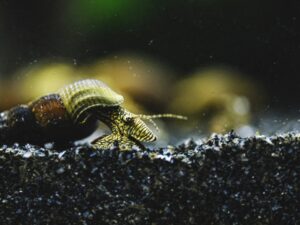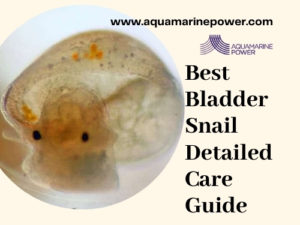The Japanese Trapdoor Snail is a freshwater snail species with a gill and an operculum, an aquatic gastropod mollusk in the family Viviparidae. Not only are they pretty and add a splash of color to your aquarium, but they are also very beneficial to your tank!
These snails scavenge and clean up the tank, eating any food or plant material that falls to the bottom. They are also peaceful creatures that will not bother other inhabitants of your tank.
In contrast, some other snails can be very destructive and cause a lot of damage to plants and aquariums. If you’re looking for a snail that will help keep your tank clean and won’t cause any trouble, the Japanese Trapdoor Snail is a great choice!
This article will discuss everything you need to know about Japanese Trapdoor Snails, including their appearance, diet, lifespan, and how to care for them.
So read on to learn all about Japanese Trapdoor Snails!
Table of Contents
- Japanese Trapdoor Snail: Species Summary
- Japanese Trapdoor Snail: Behavior & Temperament
- Japanese Trapdoor Snail: Breeding
- Japanese Trapdoor Snail: Food & Diet
- Japanese Trapdoor Snail: Care
- Japanese Trapdoor Snail: Tank size
- Japanese Trapdoor Snail: Water Parameters
- Filtration
- Heating
- CO2 System
- Lighting
- Substrate
- Aquascaping
- Adding Calcium To The Tank
- Decorations
- Japanese Trapdoor Snail: Other Tank Accessories
- Japanese Trapdoor Snail: Water Changes
- Japanese Trapdoor Snail: Cleaning The Tank
- Japanese Trapdoor Snail: Cleaning The Filter
- Japanese Trapdoor Snail: Testing
- Japanese Trapdoor Snail: Common Possible Diseases
- Japanese Trapdoor Snail: Preventing Diseases
- Japanese Trapdoor Snail: Treatment & Medications
- Japanese Trapdoor Snail: Tank Mates
- Advantages Of Having Japanese Trapdoor Snail In Your Tank
- Disadvantages Of Having Japanese Trapdoor Snail In Your Tank
- Conclusion
Japanese Trapdoor Snail: Species Summary
| Scientific name: | Cipangopaludina chinensis |
| Common name: | Japanese Trapdoor Snail, Black Snail, Trapdoor Snail, and Chinese Mystery Snails. |
| Family: | Viviparidae |
| Origin: | Japan, China, Myanmar (Burma), and Thailand |
| Maximum size: | 3 inches |
| Average Life span: | 5 to 10 years |
| Habitat: | Freshwater |
| Behavior: | Livebearers |
| Minimum Tank size: | 10 gallons |
| Temperature: | 65° – 80° Fahrenheit |
| pH range: | 6.4 – 7.8 |
| Water Hardness: | 5 – 15 dGH |
| Temperament: | Peaceful |
| Activity level: | Low |
| Care level: | Easy |
| Tank mates: | compatible with most tank inhabitants |
| Breeding: | Omnivore eats algae, residue, and other plant material |
| Diet: | Omnivore, eats algae, residue, and other plant material |
You can typically find Japanese Trapdoor Snails for sale online or at your local fish store. They are not very expensive.
To ensure your snail is healthy, look for a smooth shell with no cracks or blemishes. The shell should also be a uniform color. Avoid snails with spots or stripes on their shells, as these may indicate a health condition.
When choosing a Japanese Trapdoor Snail, it’s also essential to consider its size.
Japanese Trapdoor Snail: Appearance
The appearance of Japanese Trapdoor Snails can vary depending on the individual. However, most snails will have a dark green or black shell. The shell of these snails is typically smooth, with no bumps or blemishes.
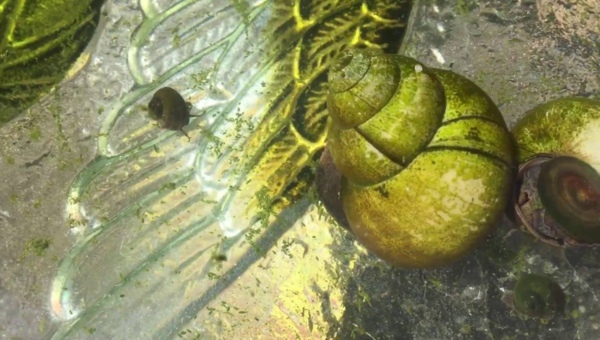
The shell of a Japanese Trapdoor Snail is also typically oval. The front of the shell is slightly larger than the back. This gives the snail a cone-shaped appearance.
Underneath the shell, Japanese Trapdoor Snails have a thin layer of flesh called the mantle. The mantle is what helps the snail to move and also protects its internal organs.
Japanese Trapdoor Snails have a long, thin feet that they use to move around. This foot is typically a light green or yellow color.
Like other snails, they have a head with two feelers or “tentacles.” These tentacles are used for smelling and feeling their way around. Bumps on the top of the head are called “eyespots.” These spots help the snail to sense light and shadows.
Japanese Trapdoor snails have an operculum that they tuck inside and pull over the opening of their shell. It serves as a trapdoor to protect them when needed.
It’s common for Japanese Trapdoor Snails to have algae and dirt on their shells. This is because they eat algae and residue from the tank floor. While this may not look pretty, it’s a good sign that your snail is healthy and eating well.
Japanese Trapdoor Snail: Size & Growth Rate
The size of a Japanese Trapdoor Snail can vary depending on the individual. However, most snails will grow to be about 3 inches in length.
The growth rate of these snails is relatively slow. They will grow slowly over several months until they reach their full size.
Once they reach adulthood, their growth will stop and no longer get bigger. It would help if you also kept in mind that the size of a Japanese Trapdoor Snail may vary depending on its age.
Japanese Trapdoor Snail: Lifespan
The lifespan of a Japanese Trapdoor Snail can vary depending on the individual and the conditions of its environment. However, most snails will live for 5 to 10 years in captivity.
Japanese Trapdoor Snails can live up to 15 years in the wild. Excellent water quality and a stable environment are vital to keeping your snail healthy and extending its lifespan.
To ensure your snail has a long and healthy life, providing it with the proper care and environment is essential. We’ll discuss how to do this later in the article.
Japanese Trapdoor Snail: Senses
Japanese Trapdoor Snails have several senses that help them survive like other snails.
Their sense of smell is powerful. This is because their tentacles are covered in sensors called chemoreceptors. These receptors allow the snail to detect smells in its environment. This helps them to find food and avoid danger.
Japanese Trapdoor Snail: Behavior & Temperament
If you have a Japanese Trapdoor Snail, you can expect it to be very active and playful. It will love to explore its surroundings and often climb up its tank’s sides. It is also a curious creature who often comes to the front of the tank to see what’s happening.
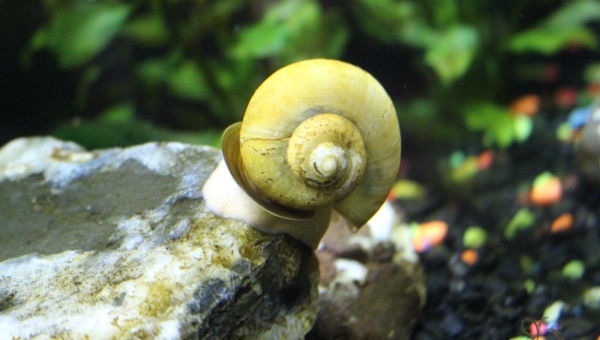
They are very peaceful creatures and will get along with most other fish. They are not aggressive and will not bother other fish in the tank.
They are also good janitors and will help to keep the tank clean. They will eat any algae that grow in the tank and help clean up any other food that is missed.
Every once in a while, you’ll see your snail poking its head out of its shell. This is a sign that the snail feels comfortable and safe in its environment. If your snail ever withdraws entirely into its shell, it feels scared or threatened.
Japanese Trapdoor Snail: Breeding
Japanese Trapdoor Snails are very easy to breed. These snails have a 9-month gestation period, so you won’t have to worry about over population. Also, their reproduction can’t occur until they are at least a year old.
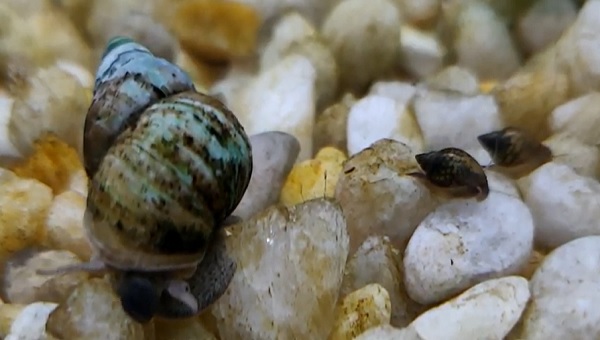
All you have to do is have some males and females in a well-maintained tank. They are live bearers, and the female will give birth up to 20 snails per cycle. Females use their tentacles to hold the babies and also use them to remove the membrane that surrounds them.
You do not need to do anything special to care for the baby snails. They will eat the same food as their parents and do not require any special treatment.
To increase your chances of getting baby snails, you can provide hiding places for female snails. You can add more than one snail to your tank to increase your chances of getting babies.
The nice thing about these species is that they will breed readily in captivity, so you can quickly increase the size of your collection by doing some simple breeding.
Remember that three are no guarantees, but following these simple tips should give you the best chance of breeding Japanese Trapdoor Snails.
So, if you are interested in breeding Japanese Trapdoor Snails, it is straightforward. Just ensure you have a well-maintained tank with optimal water parameters, and you will be on your way to having a tank full of baby snails!
Japanese Trapdoor Snail: Food & Diet
Japanese Trapdoor Snails are omnivorous, meaning they will eat plants and animals.
In the wild, they will eat:
- Algae: This is their primary source of food. They will eat both green algae and red algae.
- Crustaceans: They will eat both fresh and saltwater crustaceans.
- Mollusks: They will eat both fresh and saltwater smaller mollusks.
They will also eat dead fish and other animals.
In captivity, you can feed your Japanese Trapdoor Snail various foods.
Some good food choices include:
- Algae wafers: These wafers are made specifically for snails and other aquatic animals.
- Plant-based pellets: They will eat plant-based pellets.
- Mysis shrimp: These are small, freshwater shrimp that are high in protein.
- Brine shrimp: These are small, saltwater shrimp that are also high in protein.
- Bottom feeder tablets: They will also eat bottom feeder tablets.
You can also feed your snail a variety of vegetables.
Some good vegetable choices include:
- Broccoli: This is a high-calorie vegetable with high fiber and protein.
- Zucchini: This is a low-calorie vegetable with high water content.
- Carrots: This is a high-calorie vegetable with high fiber, water content, and vitamins.
- Cucumbers: This is a low-calorie vegetable with high water content.
- Lettuce: This is a low-calorie vegetable with high water content and fiber.
You can also feed your snail a variety of fruits.
Some good fruit choices include:
- Apples
- Bananas
- Pineapple
If you want to give your Japanese Trapdoor Snail a treat, you can also give it some cooked chicken or beef. These are high in protein and fat, so they should only be given occasional treats.
It’s essential to ensure your Japanese Trapdoor Snail has a balanced diet. You can do this by providing a variety of different foods. You should also provide a calcium-rich diet to help keep the snail’s shell healthy.
Japanese Trapdoor Snail: Diet Foods To Avoid
There are a few foods that you should avoid feeding your Japanese Trapdoor Snail.
These foods include:
- Uncooked meat: This meat is high in fat and protein.
- Sugar: This will make your snail overweight and can lead to health problems.
- Junk food: This includes things like chips, crackers, and cookies. This food is high in fat and sugar.
You should also avoid feeding your snail any processed food, which can harm its health. Processed foods are high in fat, sugar, and salt and contain few nutrients.
Japanese Trapdoor Snail: Feeding Schedule
How often you should feed your Japanese Trapdoor Snail depends on its age and size. Young snails should be fed daily, while adults should be fed every other day. If you feed your snail various foods, you can feed it less often.
Another thing to consider is the temperature of the water. In warmer water, snails will eat more often. In cooler water, they will eat less often.
A good feeding schedule for a Japanese Trapdoor Snail is as follows:
- Every day: Algae wafers
- Every other day: Blood worms, mysis shrimp, brine shrimp, plant-based pellets & bottom feeder tablets
- As needed: Cooked chicken or beef, vegetables, fruits
Providing a calcium-rich diet is also essential for the health of your Japanese Trapdoor Snail. You can do this by giving your snail a piece of cuttlebone to chew on, or you can also add a calcium supplement to its food.
Japanese Trapdoor Snail: Care
Japanese Trapdoor Snail care is not particularly difficult. These snails are very hardy and can tolerate various water conditions.
This makes them a great addition to both beginner and experienced aquarists alike. However, you should still know a few things about caring for these snails to ensure they stay healthy and happy.
It would help if you didn’t keep Japanese Trapdoor Snails in an aquarium with bigger fish, as the fish will eat the snail’s food and potentially harm or kill it. An ideal environment for these snails is a well-maintained tank with plenty of algae to eat.
Japanese Trapdoor Snail: Tank size
The ideal tank size for Japanese Trapdoor Snails is 10 gallons or larger. This will give them plenty of space to swim and explore.
If you have a smaller tank, you can still keep Japanese Trapdoor Snails, but you’ll need to be more diligent about keeping the tank clean. These snails thrive on algae growth so a clean tank will be less appealing.
However, if you can give them little algae to snack on, they’ll be just fine in a smaller tank. When setting up your tank, use a substrate safe for snails.
Gravel and sand are both excellent options. Avoid using substrates that could harm your snail, such as crushed coral or rocks. You’ll also need to provide hiding places for your snail.
Be sure to leave plenty of open space for your snail to swim.
Japanese Trapdoor Snail: Water Parameters
You have a few different options regarding water parameters for your Japanese Trapdoor Snail. The most important thing is maintaining a stable pH between 6.4 to 7.8.
You can do this by using a pH buffer in your tank. It would also help if you also aimed to keep the water temperature between 65° to 80° Fahrenheit.
Finally, you’ll need to ensure the water is well-filtered and has plenty of oxygen. An excellent way to ensure this is by using an air pump and air stone in your tank.
Water hardness is not as crucial for Japanese Trapdoor Snails, but you should aim for a hardness level between 5 to 15 dKH.
Japanese Trapdoor Snails are a great addition to any aquarium. They’re hardy, easy to care for, and they love to eat algae. You can successfully keep Japanese Trapdoor Snails in your tank with patience and basic knowledge.
Filtration
As mentioned earlier, filtration is integral to Japanese Trapdoor Snail care. These snails are susceptible to environmental changes, so ensuring the water is well-filtered and have plenty of oxygen is essential.
A quality filter will help to keep the water clean and healthy for your snail. Be sure to replace the filter media regularly to ensure optimal filtration.
When choosing a filter for your tank, be sure to get one rated for the size of your tank.
Some recommended filters for Japanese Trapdoor Snails are:
- The Aqua Clear 70: These filters are great for small to medium-sized tanks. They offer three different types of filtration: mechanical, chemical, and biological.
- The Fluval 206: This filter is perfect for larger tanks. It also offers three different types of filtration.
- The Eheim 2217 Canister Filter: This filter is perfect for large tanks. It offers four different types of filtration: mechanical, chemical, biological, and adsorptive.
- The SunSun HW-302B: This filter is excellent for small to medium-sized tanks.
Heating
As we mentioned earlier, Japanese Trapdoor Snails are very sensitive to changes in temperature. You must keep the water temperature between 65° to 80° Fahrenheit to ensure your snail’s health.
If you live in a colder climate, you must use a heater to keep the tank at the correct temperature. Be sure to buy a heater rated for the size of your tank.
Some recommended heaters for Japanese Trapdoor Snails are:
- The Aqueon Pro Heater: This heater is perfect for small to medium-sized tanks. It has a digital thermostat and is adjustable from 66° to 94° Fahrenheit.
- The Marineland Precision Heater: This heater is perfect for larger tanks. It has an LED temperature display and is adjustable from 68° to 88° Fahrenheit.
- The Zoo Med ReptiTherm Under Tank Heater: This heater is perfect for small to medium-sized tanks. It has an adjustable thermostat and can be set from 70° to 105° Fahrenheit.
CO2 System
As we mentioned earlier, Japanese Trapdoor Snails are very sensitive to changes in pH levels. You can use a pH buffer to maintain a stable pH between 6.4 to 7.8.
You can also adjust the CO2 levels in your tank to help keep the pH level stable. CO2 levels should be kept between 30 to 40 ppm.
When choosing a CO2 system, you must ensure it is the correct size for your tank. A good rule of thumb is to get a system that can deliver 1 to 2 bubbles per second.
Some recommended CO2 systems for Japanese Trapdoor Snails are:
- The AquaVista 500 Aquarium CO2 System: This system is perfect for small to medium-sized tanks. It includes a CO2 diffuser and regulator, and it can be set to deliver 1-3 bubbles per second.
- The Fluval Pressurized CO2 Kit: This system is perfect for larger tanks. It includes a CO2 diffuser, regulator, and solenoid valve, delivering 1-4 bubbles per second.
- The AquaVista 1000 Aquarium CO2 System: This system is perfect for large tanks. It includes a CO2 diffuser, regulator, and solenoid valve, and it can be set to deliver 1 to 5 bubbles per second.
Lighting
As mentioned earlier, Japanese Trapdoor Snails are very sensitive to light intensity and duration changes. You must provide 12 to 14 hours of light daily to keep your snail healthy.
You can use either fluorescent or LED lighting for your tank. When choosing a light, be sure to get one rated for the size of your tank.
Some recommended lights for Japanese Trapdoor Snails are:
- The Zoo Med Repti Sun 5.0 UVB Fluorescent Bulb: This bulb is perfect for small to medium-sized tanks. It emits 5% UVB rays and can be used with a compact fluorescent or coil bulb fixture.
- The Exo Terra Sun-Glo Basking Spot Lamp: This bulb is perfect for larger tanks. It emits 20% UVB rays and can be used with a halogen or metal halide bulb fixture.
- The Zoo Med ReptiSun 10.0 UVB Fluorescent Bulb: This bulb is perfect for large tanks. It emits 10% UVB rays and can be used with a compact fluorescent or coil bulb fixture.
Substrate
As we mentioned earlier, Japanese Trapdoor Snails are very sensitive to changes in substrate composition. You’ll need a substrate rich in calcium and other minerals to keep your snail healthy.
Some recommended substrates for Japanese Trapdoor Snails are:
- The Fluval Plant and Shrimp Stratum: This substrate is perfect for planted tanks. It is rich in calcium and other minerals and helps stabilize the pH.
- The CaribSea Arag-Alive Marine Substrate: This substrate is perfect for saltwater tanks. It is rich in calcium and other minerals and helps stabilize the pH.
- The Zoo Med Eco Earth Loose Coconut Fiber Substrate: This substrate is perfect for freshwater and saltwater tanks. It is rich in calcium and other minerals and helps stabilize the pH.
Aquascaping
When aqua scaping, you must remember that Japanese Trapdoor Snails are very sensitive to environmental changes. You’ll need to provide hiding places and plenty of calcium-rich substrates for your snail to burrow into.
Some recommended aqua-scaping products for Japanese Trapdoor Snails are:
- The Zoo Med Repti Sand
- The Fluval Plant and Shrimp Gravel
- The CaribSea Arag-Alive Marine substrate
Adding Calcium To The Tank
Adding calcium to the tank is integral to keeping your Japanese Trapdoor Snail healthy. You’ll need to add calcium to the tank at least once a week and more often if you have a lot of snails in your tank.
You can use a calcium supplement or a calcium-rich substrate to add calcium to the tank. Adding calcium to the tank will help to keep the snail’s shell healthy and robust.
Decorations
When choosing decorations for your tank, you must remember that Japanese Trapdoor Snails are very sensitive to environmental changes.
You’ll need to provide hiding places and plenty of calcium-rich substrates for your snail to burrow into.
Some recommended decorations for Japanese Trapdoor Snails are:
- The Zoo Med Repti Cave: It is perfect for small to medium-sized tanks. It is made of non-toxic plastic and provides a safe place for your snail to hide.
- The Exo Terra Rock Outcrop: This rock outcrop is perfect for larger tanks. It is made of non-toxic resin and provides a safe place for your snail to hide.
Japanese Trapdoor Snail: Other Tank Accessories
In addition to the substrate, decorations, and lighting, you’ll also need to provide a few other tank accessories for your Japanese Trapdoor Snail.
Some recommended tank accessories for Japanese Trapdoor Snails are:
- An Air stone: This is perfect for both freshwater and saltwater tanks. It helps keep the water oxygenated and provides a nice bubbling effect.
- Aquarium Salt: This is also perfect for both freshwater and saltwater tanks. It helps keep the water stable and provides a friendly mineral content for your snail.
- Thermometers: This is perfect for both freshwater and saltwater tanks. It helps monitor the water temperature and ensure it is within the correct range.
- pH Meters: This is also perfect for both freshwater and saltwater tanks. It helps monitor the pH levels and ensure they are within the correct range.
Japanese Trapdoor Snail: Water Changes
Water Changes are an essential part of keeping your Japanese Trapdoor Snail healthy. You’ll need to do a water change at least once a week and more often if you have a lot of snails in your tank.
To do a water change, you’ll need to:
- Remove all the snails from your tank and place them in a separate container filled with clean water.
- Drain the dirty water from your tank and replace it with clean, fresh water.
- Add the snails back into the tank.
- Repeat steps 2 to 4 until all the water has been replaced.
- Test the water parameters and make any necessary adjustments.
- Enjoy your healthy, happy Japanese Trapdoor Snails!
Japanese Trapdoor Snail: Cleaning The Tank
Cleaning the tank is integral to keeping your Japanese Trapdoor Snail healthy. You’ll need to clean the tank at least once a month and more often if you have a lot of snails in your tank.
You must remove the snail’s food and waste when cleaning the tank. You can do this by siphoning the water out of the tank or using a gravel vacuum.
After removing all the food and waste from the tank, you must add fresh water. You can use a water conditioner to remove any chlorine from the water.
Finally, you’ll need to add some calcium-rich substrate to the tank. This will help to keep the snail’s shell healthy and robust.
Japanese Trapdoor Snail: Cleaning The Filter
Cleaning the filter is essential to keeping your Japanese Trapdoor Snail healthy. You’ll need to clean the filter at least once a week and more often if you have a lot of snails in your tank.
To clean the filter, you’ll need to remove it from the tank and disassemble it. You can then rinse the media in clean, fresh water.
After you’ve rinsed the media, you’ll need to soak it in dechlorinated water for about 30 minutes. This will help to remove any build-up of slime or algae.
Finally, you must reassemble the filter and put it back in the tank.
Japanese Trapdoor Snail: Testing
Testing the water parameters is integral to keeping your Japanese Trapdoor Snail healthy. You’ll need to test the water parameters at least once a week and more often if you have a lot of snails in your tank.
You’ll need a pH meter, a thermometer, and an ammonia test kit to test the water parameters.
You’ll need to test the pH levels and ensure they are within the correct range. The ideal pH level for Japanese Trapdoor Snails is between 6.4 and 7.8.
You’ll also need to test the water temperature and ensure it is within the correct range. The ideal water temperature for Japanese Trapdoor Snails is between 65° and 80° Fahrenheit.
Finally, you’ll need to test the ammonia levels and ensure they are within the correct range. The ideal ammonia level for Japanese Trapdoor Snails is 0 ppm.
Japanese Trapdoor Snail: Common Possible Diseases
As with any pet, there is always the potential for your Japanese Trapdoor Snail to become sick.
Some of the most common diseases that affect Japanese Trapdoor Snails are:
- Shell Rot: This is a disease that affects the snail’s shell. A bacteria or fungus causes it, which can be deadly if left untreated.
- Ammonia Poisoning: High levels of ammonia levels water cause this condition. Ammonia poisoning can cause the snail to lose its mucous membrane, eventually leading to death.
- Pneumonia: This is a condition that is caused by a bacterial infection. It can cause the snail to lose its mucous membrane, eventually leading to death.
- Oedema: This condition is caused by an accumulation of fluid in the tissues. It can cause the snail to lose its mucous membrane, eventually leading to death.
Some other less common illnesses can affect Japanese Trapdoor Snails, but these are the most common. If you think your snail may be sick, taking it to a veterinarian as soon as possible is essential.
Japanese Trapdoor Snail: Preventing Diseases
There are a few things that you can do to prevent your Japanese Trapdoor Snail from becoming sick.
The most important thing is to keep the water parameters within the correct range. You can do this by testing the water regularly and making sure that you are using a dechlorinator.
You should also make sure to clean the tank regularly. You should remove all the food and waste from the tank and add fresh water. You can also use a water conditioner to remove any chlorine.
Finally, you’ll need to add some calcium-rich substrate to the tank. This will help to keep the snail’s shell healthy and robust.
If you follow these tips, you’ll be well on your way to keeping your Japanese Trapdoor Snail healthy and happy!
Japanese Trapdoor Snail: Treatment & Medications
There are a few things that you can do to treat diseases in Japanese Trapdoor Snails.
The most important thing is to get the snail to a veterinarian immediately. The veterinarian can diagnose the disease and prescribe the correct medication.
Some of the most common medications that are used to treat diseases in Japanese Trapdoor Snails are:
- Amoxicillin: This is a medication that is used to treat bacterial infections.
- TetraSan: This is a medication that is used to treat fungus infections.
- Furaltadone: This is a medication that is used to treat protozoan infections.
- Metronidazole: This is a medication that is used to treat anaerobic infections.
If you think your Japanese Trapdoor Snail may be sick, taking it to a veterinarian as soon as possible is essential. The veterinarian can diagnose the disease and prescribe the correct medication.
Japanese Trapdoor Snail: Tank Mates
When choosing tank mates for your Japanese Trapdoor Snail, there are a few things to keep in mind.
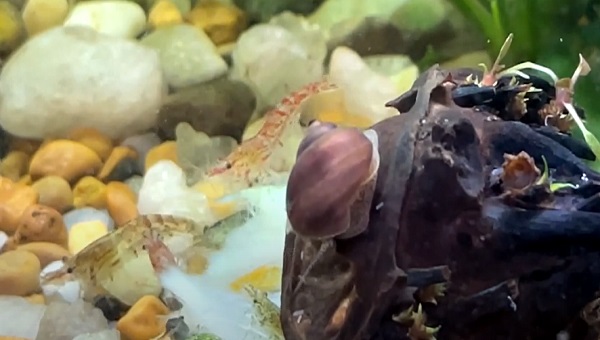
First, you should ensure that the other fish in the tank are peaceful and will not bother the snail. Secondly, you should make sure that the other fish are of a similar size to the snail. If the other fish are too big, they could eat the snail.
Some good tank mates for a Japanese Trapdoor Snail include:
Japanese Trapdoor Snails can also be kept with other snails, such as:
- Mystery Snails
- Nerite Snails
- Gold Inca Snails
- Ramshorn Snails
- Assassin Snails
These snails are all peaceful and will not bother each other.
If you want some variety, shrimp are also a good option. They are peaceful and come in a variety of different colors. They are also small, so they will not bother the snail.
Some good shrimp tank mates for a Japanese Trapdoor Snail include:
These shrimp are also good janitors and will help to keep the tank clean.
As you can see, various fish and shrimp make good tank mates for a Japanese Trapdoor Snail. When choosing tank mates, ensuring they are peaceful and will not bother the snail is essential. You should also make sure that they are of a similar size to the snail.
Japanese Trapdoor Snails are very easy to care for and make great additions to most tanks. With their playful personalities and helpful janitorial skills, these snails will surely be a hit with you and your fish!
If you follow these guidelines, you can be sure that your snail will have a happy and safe home.
Advantages Of Having Japanese Trapdoor Snail In Your Tank
The first advantage of having Japanese Trapdoor Snails in your tank is that they are very good at keeping it clean. These snails are excellent janitors and will help to keep your tank free of algae and other debris.
They will also eat uneaten food and fish waste, which helps to keep the water quality high.
Another advantage of these snails is that they are very peaceful. They will not bother other fish or invertebrates in the tank and can be kept with shrimp. This makes them a great addition to most community tanks.
Lastly, these snails are very easy to care for. They do not require any special treatment and are very hardy. If you provide them with a clean tank and some food, they will be happy and healthy.
So, if you are looking for a peaceful, easy-to-care-for snail, the Japanese Trapdoor Snail is a great choice!
Disadvantages Of Having Japanese Trapdoor Snail In Your Tank
The only disadvantage of keeping Japanese Trapdoor Snails in your tank is that they can be slightly shy. They may not come out of their shells as much as some other snails and may take a while to get used to their new home.
However, with some patience, these snails will adjust to their new surroundings and soon be busily cleaning your tank.
Conclusion
As you can probably see, there are many advantages to keeping Japanese Trapdoor Snails in your tank. They are excellent janitors, are very peaceful, and are very easy to care for. So, if you are looking for a good snail for your tank, the Japanese Trapdoor Snail is a great choice!
I hope this has helped you to learn all about Japanese Trapdoor Snails!
Thanks for reading!

